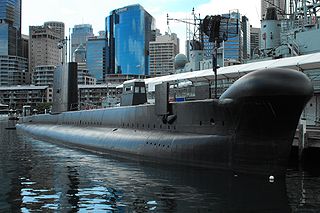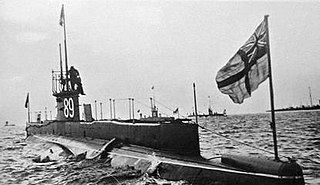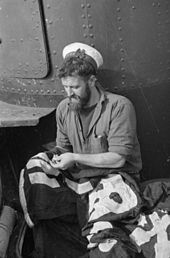
Jolly Roger is the traditional English name for the ensign flown to identify a pirate ship preceding or during an attack, during the early 18th century. The vast majority of such flags flew the motif of a human skull, or “Death's Head”, often accompanied by other elements, on a black field, sometimes called the “Death's Head flag” or just the “black flag”.

HMAS Onslow is one of six Oberon-class submarines, previously operated by the Royal Australian Navy (RAN). The submarine was named after the town of Onslow, Western Australia, and Sir Alexander Onslow, with the boat's motto and badge derived from Onslow's family heritage. Ordered in 1963, Onslow was laid down at the end of 1967 by Scotts Shipbuilding and Engineering Company in Scotland, launched almost a year later, and commissioned into the RAN at the end of 1969.

HMAS Ovens is an Oberon-class submarine, formerly of the Royal Australian Navy (RAN). She was one of six Oberons built for the Royal Australian Navy by the Scottish Scotts Shipbuilding and Engineering Company, and entered service in 1969. The vessel was named for Irishman and Australian explorer John Ovens (1788–1825) and for whom the Victorian river Ovens was named. During her career, Ovens was the first RAN submarine to deploy with the ANZUK force, and the first RAN submarine to fire an armed Mark 48 torpedo, sinking the target ship Colac. The boat was decommissioned in 1995, and is preserved at the Western Australian Maritime Museum as a museum ship.

HMS Trump was a British submarine of the third group of the T class. She was built by Vickers-Armstrongs, Barrow, and launched on 25 March 1944. So far she has been the only ship of the Royal Navy (RN) to bear the name Trump. She spent the majority of her life attached to the 4th Submarine Squadron based in Australia. She was kept in service following the war and was refitted for greater underwater performance, and was the final RN submarine to be posted in Australia, departing in January 1969. She was sold off and broken up for scrap in August 1971.

HMS Arab was a B-class torpedo boat destroyer of the British Royal Navy. She was laid down by J & G Thomson at Clydebank and completed by John Brown & Company who took over the yard.

Admiral Sir Max Kennedy Horton, was a British submariner during the First World War and commander-in-chief of the Western Approaches in the later half of the Second World War, responsible for British participation in the Battle of the Atlantic.

ORP Sokół was a U-class submarine built by Vickers-Armstrong at Barrow-in-Furness. Shortly after launching in September 1940 she was to be commissioned by the Royal Navy as HMS Urchin, but instead was leased to the Polish Navy due to a lack of experienced submarine crews. A sister boat to Dzik, both boats operated in the Mediterranean from Malta, where they became known as the "Terrible Twins".

HMS Otus was a Royal Navy Oberon-class submarine launched in 1962. She was decommissioned in the early 1990s and is now a museum ship in Germany.

The Royal Navy Submarine Service is one of the five fighting arms of the Royal Navy. It is sometimes known as the Silent Service, as submarines are generally required to operate undetected.

The Royal Australian Navy Submarine Service is the submarine element of the Royal Australian Navy. The service currently forms the Navy's Submarine Force Element Group (FEG) and consists of six Collins class submarines.

A depot ship is an auxiliary ship used as a mobile or fixed base for submarines, destroyers, minesweepers, fast attack craft, landing craft, or other small ships with similarly limited space for maintenance equipment and crew dining, berthing and relaxation. Depot ships may be identified as tenders in American English. Depot ships may be specifically designed for their purpose or be converted from another purpose.

HMAS Otway was an Oberon-class submarine of the Royal Australian Navy (RAN). One of the first four Oberon-class boats ordered for the RAN, Otway was built in Scotland during the mid-1960s, and commissioned into naval service in 1968. The submarine was decommissioned in 1994. The submarine's upper casing, fin, and stern are preserved at Holbrook, New South Wales.

HMS Oxley was an Odin-class submarine of the Royal Australian Navy (RAN) then Royal Navy (RN). Very slightly off course, near Obrestad, on the south-western cape of Norway, she was hit by friendly fire seven days after the start of World War II costing 53 lives and leaving two survivors.

HMS E9 was a British E class submarine built by Vickers, Barrow. She was laid down on 1 June 1912 and was commissioned on 18 June 1914.

Vice-Admiral Sir Arthur Richard Hezlet, nicknamed Baldy Hezlet, was a decorated Royal Navy submariner. He became the Royal Navy's youngest captain at the time – aged 36 – and its youngest admiral, aged 45. In retirement he became a military historian.

HMS Phoenix was a Parthian-class submarine of the Royal Navy, launched in 1929. She was the eighteenth warship of the Royal Navy to use the name Phoenix. She served on the China Station from her commissioning until the start of the Second World War. Phoenix was then relocated to the Mediterranean Sea and was sunk by the Italian torpedo boat Albatros on 16 July 1940.

Commodore Submarine Service is a post in the Royal Navy which involves command of the Royal Navy Submarine Service. It evolved from the post of Inspecting Captain of Submarines in 1901 and would later evolve to become the post of Flag Officer Submarines in 1944.

Vice-Admiral Sir Hugh Stirling Mackenzie, was a Royal Navy officer who became Flag Officer Submarines and Chief Polaris Executive.

Captain Michael Lindsay Coulton "Tubby" Crawford DSC & Bar was an officer in the Royal Navy and submariner.





















